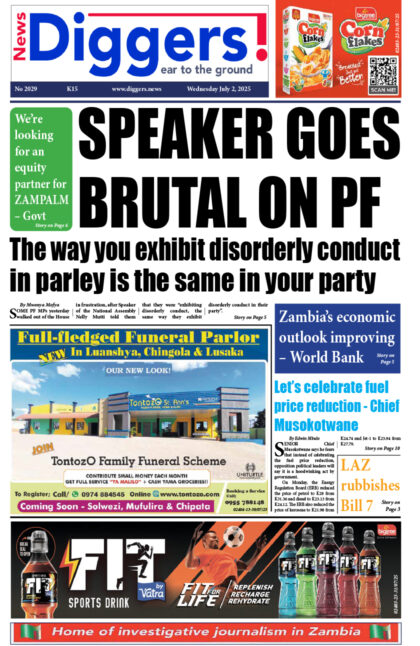Government has signed a €28.4 million grant agreement with the European Union (EU) and KFW of the Federal Republic of Germany to finance the sustainable access to electricity in the southern region of Zambia.
And German Embassy Head of Cooperation Dr Christoph Ritz says the project is expected to make more power available for distribution to both households and businesses as well as allow feed-in additional renewable energies to the grid.
Speaking at the signing in ceremony in Lusaka, Tuesday, Finance Minister Margaret Mwanakatwe said support to the energy sector is essential to ensuring access to clean safe, reliable and affordable energy at the lowest cost.
“Through the signing of this grant agreement, that you have just witnessed, KFW will provide a grant of €18.0 million, or K211 million equivalent, to finance the ‘sustainable access to electricity in southern division component’ project and the EU, through KFW, will provide a grant of €10.4 million, or K122 million equivalent, for the implementation of the ‘access component’ project to be implemented by Zesco. The Zambian government has committed itself to grow and diversify the energy sector by expanding power generation and transmission capabilities as espoused in the Seventh National Development Plan (7NDP). Support to this sector is essential to ensuring universal access to clean, safe, reliable and affordable energy at the lowest cost consistent with Zambia’s national development aspirations, as well as the United Nations Sustainable Development Goals,” Mwanakatwe said.
She said the funds will go towards rehabilitation and reinforcement of selected power transmission and distribution infrastructure in the region because the existing infrastructure to serve the current electricity load is insufficient.
“Through the ‘sustainable access to electricity in ‘southern division component’ project and ‘access component’ project, as a result of this grant agreement that we have just signed; firstly, you may wish to know that, a large part of the transmission and distribution network in this service area still dates from the pre-Independence-era, and the capacity of the existing infrastructure to serve the current load is insufficient. In this regard, these funds will [go] towards the rehabilitation and reinforcement of selected power transmission and distribution infrastructure in the southern division of Zambia,” Mwanakatwe explained.
“Secondly, through the rehabilitation and reinforcement of the grid, the project will improve security of supply, reduce power losses and enhance energy efficiency in the system. Consequently, more power will be available for distribution and more households and productive users will be connected. Lastly, under the ‘access component’ project, these funds will be used to connect small businesses and households in areas currently not connected to the national grid, but are located in the vicinity of the project region.”
Mwanakatwe further explained how the projects will be financed.
“Firstly, rehabilitation and reinforcement measures: the project will finance a selection of rehabilitation and reinforcement measures, otherwise, referred to also as R&R measures, and have been confirmed by Zesco as the highest priority investment. Further, the project will finance the R&R measures, which will include works at 12 substations ranging from 132 KV down to 11 KV and several other new transmission lines at voltage levels of 132 KV, 66 KM and 33 KV. Secondly, the project will finance contracting of a consulting engineer during implementation and construction phase. Last but not the least, under the ‘access component’ the project will finance the connections to the grid or improve electricity supply to identify Rural Growth Centres (RGC) and low-cost urban areas falling within the project areas,” she said.
And Dr Ritz explained that KFW, his country’s development bank, was the lead financier of the project.
“This is expected to make more power available for distribution so that more households and businesses can be connected. It will also allow to feed-in additional renewable energies to the grid. The project is a good example of European-Zambia cooperation. The investment of 86.9 million euros is jointly-financed by France and Germany and includes a contribution from the EU focused on the implementation of an access component. Germany’s development bank KFW is the lead financier. The financing contracts to be signed today covers 28.4 million euros from Germany and the EU. For the overall project, Germany provides a grant of 36.5 million via KFW and France provides a concessional loan of 40 million euros. The EU contributes a grant of 10.4 million euros via the Africa Infrastructure Trust Fund. Ensuring energy access for all will require reforms in the energy sector. Zambia’s overall debt sustainability and the financial health of Zesco are important preconditions for investment in the energy sector,” Dr Ritz explained.
And EU Delegation to Zambia and COMESA Gianluca Azzoni encouraged the Zambian government and Zesco to make the most out of the financial package.
“The EU is contributing grant financing to this project to a tune of 10.4 million euros, which comes on top of the envelop already allocated under the bilateral EU-Zambia cooperation programme of the 11th European Development Fund (for the period 201-2020). The EU contribution comes from the EU Sustainable Energy for all window of the EU-Africa Investment facility set up to promote access to affordable, reliable and clean energy in African-partner countries in line with Sustainable Development Goal 7. I am informed that the project aims at establishing at least 12,000 new connections to households and 200 new connections to commercial/public users representing a total of more than 60,000 citizens with access to grid-connected power. I would like to encourage the Government of Zambia, and Zesco in particular, to make most use out of this financing package,” said Azzoni.


















